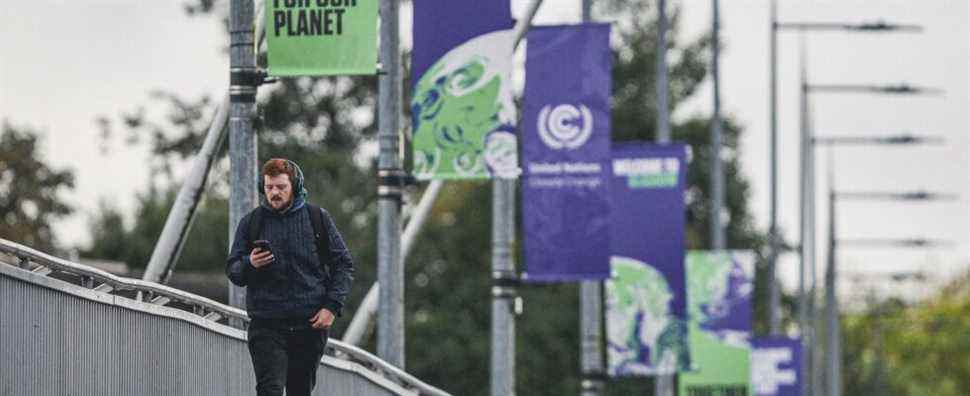In 2015, in Paris, the COP21 ended with the signing of a historic agreement. For the first time, more than 190 countries pledged to reduce their greenhouse gas emissions, so as to limit average global warming to below 2 ° C, ideally to 1.5 ° C compared to the pre-industrial era. The COP26, which opens in Glasgow (Scotland) on Sunday 31 October, promises to be less resounding, but no less crucial.
Postponed for a year due to the Covid-19 pandemic, this global climate conference asks the following questions: what have we done since the Paris Agreement and how to take the trajectory that will truly honor it ? Discussions – between heads of state at first, then between diplomats and negotiators – will be concrete, technical and inevitably heated. Because this COP26 must transform promises – reduce greenhouse gas emissions by 45% by 2030 and achieve carbon neutrality around 2050 – into reality.
Ambitions revised upwards for 2030
In 2015, the countries that signed the Paris Agreement officially published their greenhouse gas reduction ambitions in documents called CND. At the time of the first assessment, governments “are not up to the task”, recalls UN Secretary General Antonio Guterres, calling on countries – especially members of the G20, which represent three-quarters of global emissions and meet at the same time in Rome – to present, before or during the Glasgow summit, contributions compatible with the 1.5 ° C target. As time is running out, commitments must be strengthened by 2030.
Indeed, according to a recent UN report, even with the latest commitments announced by states for 2030, the planet is heading towards warming. “catastrophic” of + 2.7 ° C by the end of the century. However, nothing prevents countries that have already updated their contributions from further strengthening their ambition. British COP26 President Alok Sharma sums up his mission in Glasgow: “keep the 1.5 ° C target alive” (“Keep 1.5 ° C alive”).
If the Paris agreement provides for ambitions to be revised upwards every five years, the most vulnerable countries will fight for their part to revise ambitions every year, in view of the urgency, such as expressed it in September in The Times the President of the Maldives.
Strategies for abandoning fossil fuels
“People are tired of seeing only commitments and goals and not specific action plans”, considers Laurence Tubiana, Ambassador of France in the negotiations of the Paris Agreement. How to give credibility to abstract political announcements, such as carbon neutrality by 2050? While coal-fired power stations are still under construction, especially in China, this summit should provide the opportunity to ask States to present long-term development strategies with low greenhouse gas emissions (strategies called LT-Leds in the UN language).
What’s more, “Multilateral climate conferences provide a high-level platform to launch and take stock of public and private initiatives aimed at advancing real economy actions”, notes the Institute for Sustainable Development and International Relations (Iddri), which notes strong expectations regarding new commitments in favor of coal reduction. Thus, the Climate Action Network, a network that brings together more than a hundred NGOs around the world, is waiting for this summit to be the one for the end of public funding allocated to coal-fired power plant projects.
A transfer of money from rich countries to developing ones
Among the crucial topics of this COP26 is also solidarity between the North, responsible for global warming, and the South, on the front line in the face of the effects of climate change. More specifically, the still unfulfilled promise of developed countries to increase their assistance to poor countries to $ 100 billion per year by 2020 to adapt to the consequences and reduce their greenhouse gas emissions.
A report presented at the end of October by the presidency of the COP26, estimates that it is possible to reach 100 billion in 2023 and then exceed them each year. To do this, upstream from the summit, lCanada and Germany have been tasked by the British Presidency to prepare a plan clarifying how developed countries could collectively step up their efforts, especially over the period 2021-2025.
A user guide for carbon markets
Another contentious subject at the heart of the two weeks of discussions: carbon markets. This system of emission quotas applied to States in order to make the abandonment of fossil fuels more financially attractive, is described in Article 6 of the Paris Agreement. But it is still necessary to agree on the functioning of these markets which require that the countries communicate in full transparency on their objectives and their emissions.
According to IDDRI, “rather, the real problem seems to be political. Brazil, the main blocking country on this subject, needs to be reassured that there will be financial incentives for the preservation of the Amazon rainforest and its contribution to the stability of the global climate “. However, the negotiations carried out before COP26 on this subject did not yield anything, observe the observers.
The finalization of the rules of the game of the Paris Agreement
Six years after the adoption of the Paris Agreement, countries are finally entering the first cycle of implementing their commitments. However, the agreement’s application manual, supposed to allow its rigorous implementation, has still not been adopted, notes the Climate Action Network. In Glasgow, “States must adopt a common 5-year calendar (…) to enable them to regularly take stock of their objectives, as well as uniform and transparent reporting rules”, writes the organization.
The states “must also submit to the evaluation mechanism of the Paris agreement, which must be put in place for the first time in 2023. It is the credibility of the Paris agreement that is at stake, because the rules are fine. defined will allow better transparency “.
